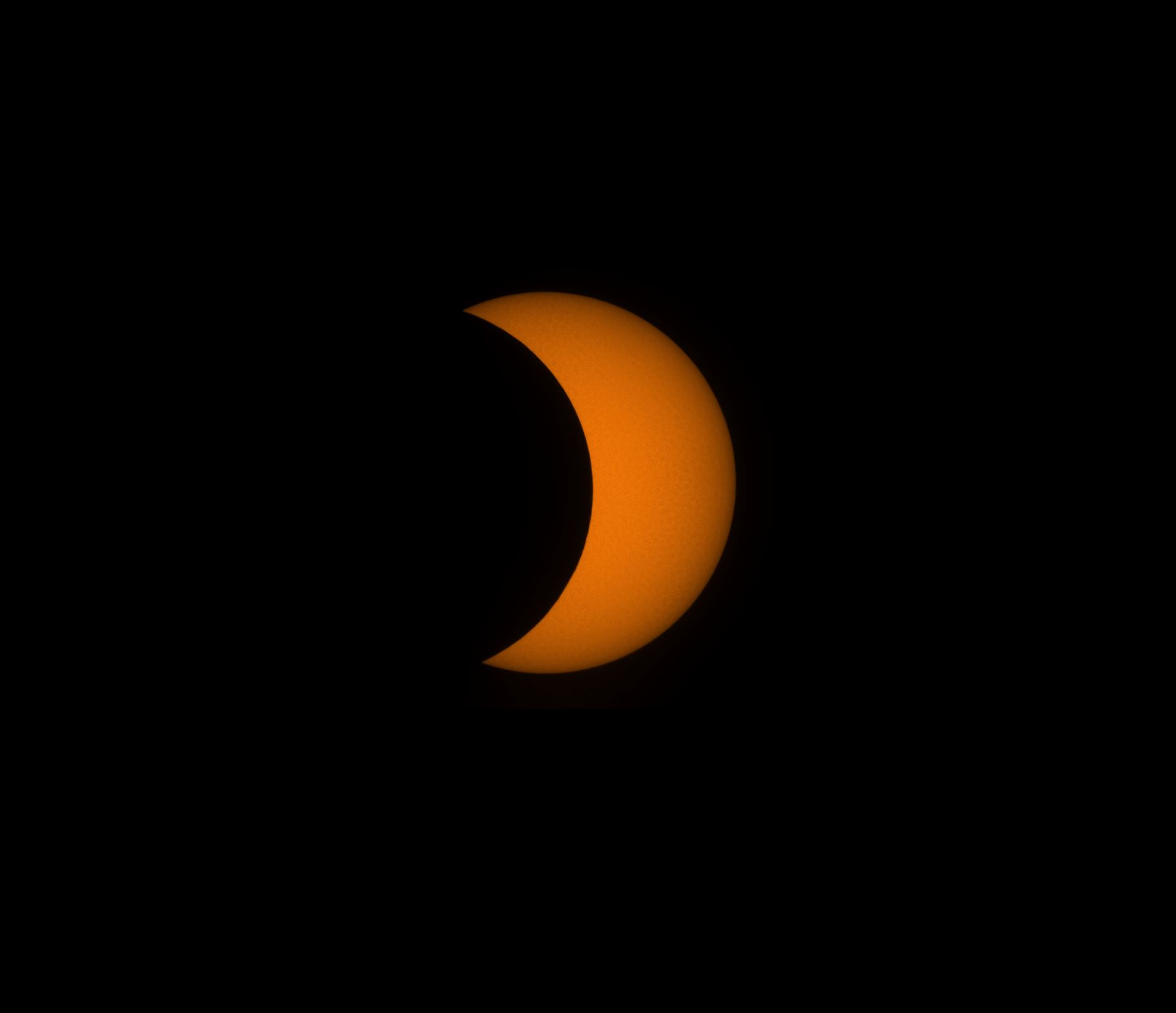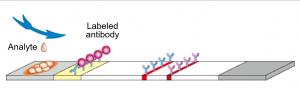On June 21, 2020, a partial solar eclipse appeared for two hours and 11 minutes, in which the Moon hid part of the Sun. In Seoul, the solar eclipse started at 3:53 p.m. and ended at 6:04 p.m., after the Moon hid 45% of the Sun at 5:02 p.m. The Korea Astronomy and Space Science Institute and the Gwacheon National Science Museum broadcasted the eclipse online. This year's solar eclipse will happen twice, but the total solar eclipse scheduled for December will not be seen in Korea. So, this solar eclipse was the last solar eclipse in the 2020s that could be observed in Korea. The next solar eclipse is on June 1, 2030.
 |
| 2020.06.21. Partial Solar Eclipse |
Recorded Lunar Eclipses
The total lunar eclipse that happened on March 19, 721 as seen by Babylonian astronomers was the first officially recorded lunar eclipse. In Korea, there are many records of lunar eclipses in various history books, such as The Chronicles of the Three States, The History of Goryeo, and The Annals of the Joseon Dynasty. There are records of a total lunar eclipse happening on May 24, 1016 (lunar calendar April 16, 1016) in The History of Goryeo, Vol. 5, page 18, and a total lunar eclipse happening on November 26, 1425 (lunar calendar October 17, 1425) in the 2nd book of The Annals of the Joseon Dynasty, page 696. It is assumed that the Chinese history book Joo Seo (周書) recorded a lunar eclipse that occurred in the 12th century B.C. The Cloud, written by the ancient Greek comedy writer Aristophanes, records a lunar eclipse that occurred in 421 B.C.
A Lunar Eclipse That Was Considered Unfavourable in the Past
People feared lunar eclipses until their cause was scientifically identified. The reasons why ancient people feared a lunar eclipse are because the Moon disappears, and because it looks red when a total lunar eclipse happens. In the past, a red moon was perceived as ominous and as a sign of disaster. Even in the West, a red moon that occurs during a lunar eclipse is called a "blood moon". Greek mythology also says that the goddess Hecate appears on the day the red moon rises, with a dog from the underworld, and wielding a magic spell.
 |
| Blood Moon |
The Present Has a Different Response to Astronomical Phenomena Compared to the Past
In the past, the scientific causes of astronomical phenomena such as lunar eclipses were not understood, so they were recognized as signs of disaster. However, in the present day, we learn the causes of astronomical phenomena, take them as natural phenomena, observe them, and use them to examine other phenomena. This applies not only to scientists and astronomers, but also to the general public. People can easily know when astronomical phenomena occur through news and other media. Some astronomical phenomena can also be observed without special equipment, so people may go outside to observe them directly. Astronomical phenomena can be amazing for us, but they are not scary for most people anymore.
Types of Solar Eclipses
There are three types of solar eclipses: total solar eclipses, annular solar eclipses, and partial solar eclipses. First, a total solar eclipse is a phenomenon in which the Moon completely covers the Sun when it is arranged in the order of the Sun-Moon-Earth. Second, an annular solar eclipse is called an annular eclipse. This occurs when the Earth is closest to the Sun and farther away from the Moon. Finally, a partial solar eclipse is a phenomenon in which only a part of the Sun is hidden from the Moon in the area of the Earth which is in the half shadow of the Moon. During the total solar eclipse, the Moon hides the Sun the most. During the annular solar eclipse, the Moon hides the Sun the second most. During the partial solar eclipse, the Moon hides the Sun the least.
 |
| Total Solar Eclipse |
 |
| Annular Solar Eclipse |
 |
| Partial Solar Eclipse |
Solar and Lunar Eclipses and the Differences Between Them
A solar eclipse is a phenomenon that occurs not because the Moon itself covers the Sun, but because of the Moon's shadow. The Sun, the Moon, and the Earth all move at high speeds, so the time the eclipse lasts is very short. A lunar eclipse is a phenomenon in which the Moon “disappears”. A solar eclipse occurs because of the position of the Sun-Moon-Earth, but a lunar eclipse is not because of the position of the Moon-Sun-Earth. The fact that a lunar eclipse occurs because of the position of the Sun-Earth-Moon is fundamentally different from a solar eclipse. If the Earth is located between the Sun and the Moon, it would be impossible to observe the Moon from the Earth. Therefore, the Moon doesn't “disappear”. It is more accurate to say the lunar eclipse "is not seen on the Earth."
Types of Lunar Eclipses
There are also total lunar eclipses and partial lunar eclipses. A total lunar eclipse appears when the Moon passes through the umbra of the Earth. A lunar eclipse lasts longer than a solar eclipse, and only occurs on the 15th of the month on the lunar calendar. This happens because only when the Earth is at the center and the Moon is placed in the opposite direction of the Sun, can the Moon enter the shadow of the Earth.
 |
| Total Lunar Eclipse |
 |
| Partial Lunar Eclipse |
The Total Lunar Eclipse That Drew Attention in 2018
The total lunar eclipse of January 31, 2018 attracted attention because of the “super moon”, which is when the Moon approaches the Earth and looks bigger than usual. On the same day a “blue moon” and a “blood moon” occurred. A blue moon is the second full moon among the full moons that sometimes appear twice in a month, and a blood moon is a moon which turns red during the total lunar eclipse. The Korea Astronomy and Space Science Institute explained that a partial lunar eclipse would start at 8:48 p.m. on that day, and that a total lunar eclipse would appear from 9:51 p.m. to 11:08 p.m. and the Moon would turn red. And, on the next day (February 1, 2018), the partial lunar eclipse would end around 12:11 a.m. It was the first time in 35 years that a super moon and a blue moon appeared together.
 |
| Super Moon |
 |
| Blue Moon |
 |
| Blood Moon |
Astronomical Phenomena Remaining this Year
There is not much time left in this year, but there are still astronomical phenomena that can be observed. You will be able to see a blue moon on October 31 of this year. This Moon (it will be its roundest at 11:49 p.m.) will be the smallest full moon in 2020. A penumbral lunar eclipse will take place on November 30. This eclipse begins in Korea at 4:32 p.m., but we will be able to see it at 5:13 p.m., when the Moon rises. It will reach its maximum at 5:42 p.m. and end at 8:55 p.m. The Gemini meteor shower will occur on December 14. This meteor shower appears when the Earth passes through the debris trail of 3200 Phaethon on its way around the Sun. The 14th, the maximum day of the Gemini meteor shower is the last day of the month in the lunar calendar, so it's perfect for observation because that night is the darkest in that month. On December 21, there will be a conjunction between Jupiter and Saturn. Soon after sunset (5:17 p.m.), in the west, Jupiter and Saturn will come as close as 0.1 degree to each other. These two will be so close to each other that they will look stuck together. This scale of the conjunction will be the first in 20 years. However, it will be observed in the west immediately after sunset, so careful observation is required.
 |
| Blue Moon |
 |
| Penumbral Lunar Eclipse |
Solar Eclipse Observation Method and Caution
Solar eclipses can be observed easily, but there are some things to watch out for. If you look directly at strong sunlight with the naked eye, there is a possibility of damaging your eyes. It is important to be aware that covering your eyes with dark sunglasses or translucent materials during a solar eclipse may not block ultraviolet rays, or may not block out enough sunlight to protect your eyes. When using a solar observation filter, it is necessary to confirm that the international standard "ISO12312-2" or "OD(transmittance)" is 5.0. The Korea Astronomy and Space Science Institute and the National Aeronautics and Space Administration (NASA) recommend that observations be made for less than three minutes to protect your eyes. In order to see eclipses with the naked eye, you must use tools, like several layers of dark-colored cellophane paper or a silver-lined snack bag. Alternatively, you can make a small hole in a piece of paper and then make a "Needle Hole Camera" to project it on another piece of paper to observe the solar eclipse.
Good Places to Observe a Lunar Eclipse
Anyone can observe a lunar eclipse directly with the naked eye without necessarily observing it with a telescope at an observatory. There are lots of good places to observe a lunar eclipse, such as these:
 |
| Achasan Mountain, Gwangjin-gu |
 |
| N Seoul Tower, Jung-gu |
Solar eclipses can be observed by everyone. They can be viewed with the naked eye or in other simple ways. The same is true of other astronomical phenomena. Now that you're hesitating to go to indoor places where people gather because of the corona virus, why don't you go out with people around you to observe astronomical phenomena? As mentioned above, there are still many astronomical phenomena that can be observed this year. Of course, it is good to visit Achasan Mountain or N Seoul Tower, which are considered good for viewing lunar eclipses, but astronomical phenomena can be observed near your home, too. How about looking for a quiet place, observing astronomical phenomena with people around you, and practicing social distancing? Also, it is a “small but certain happiness” and an opportunity to become more interested in astronomical phenomena. Don't miss this opportunity!
Yoon Sun-young sunflower0180@naver.com
<저작권자 © 홍익대영자신문사, 무단 전재 및 재배포 금지>





